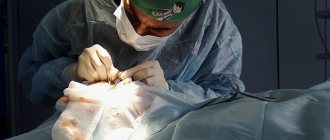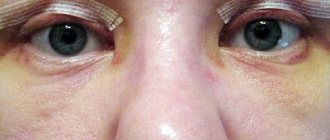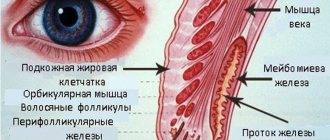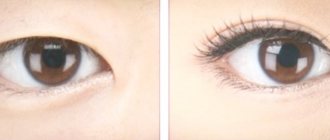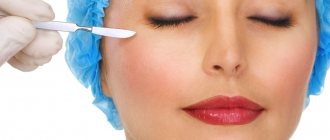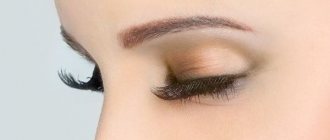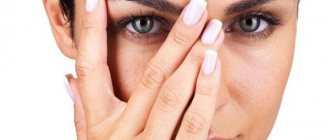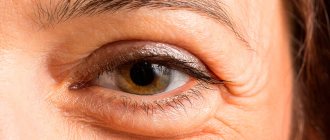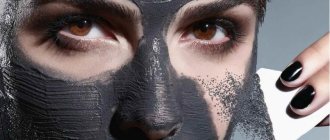Asian eye surgery - features of the procedure
This type of blepharoplasty allows you to change the shape of the patient's eyes. The doctor removes the overhanging tissue of the upper eyelid and forms a fold. As a result, the eyes “open” and visually enlarge, although, of course, in reality the size of the orbit and eyeball does not change. Asian eyelid surgery in Moscow is performed in two ways:
- With a cut. The procedure can significantly change the shape of the eyes. The surgeon makes incisions in the folds of the eyelid, so the stitches are not visible. The disadvantage of the method is a longer rehabilitation period.
- No cut. A more gentle, but less effective option. In this case, the doctor still makes incisions. They are simply located not on the skin, but on the surface of the mucous membrane. This method is used only if the tissues of the upper eyelid are quite thin.
Europeanization of the upper eyelids
41,000 rubles
Sign up for a consultation
Blepharoplasty is performed under both general and local anesthesia. It lasts about two hours. After the operation, the patient is given a bandage. You will have to stay in the hospital for several hours under the supervision of specialists.
The first results of the procedure are noticeable after 2 weeks. The surgeon will remove the sutures after 4-5 days for blepharoplasty without incisions and after 8-9 for surgery with incisions. After this, you can apply makeup and use your usual cosmetics. The scars will completely disappear in a month.
Characteristic features of ethnic blepharoplasty
Surgeons call plastic surgery of Asian eyelids the Singapore operation, and emphasize that this concept includes a set of measures aimed at changing the structural features of oriental eyes. The main goal of plastic correction is to make the look more open by removing part of the periorbital fat, forming a double fold on the upper eyelid and removing the epicanthus (the fold of skin that covers the lacrimal corner).
There are two ways of performing ethnic blepharoplasty:
- with a cut;
- without incision (suture plasty).
Blepharoplasty with an incision is the gold standard for surgical Europeanization of the eyelids, because it allows you to get the maximum result and solve several problems at once - remove fatty deposits and epicanthus, form a double fold on the eye and expand the eye orbit. The surgeon makes incisions in the natural folds of the skin, which makes post-operative scars almost invisible, and then applies several cosmetic stitches. The disadvantage of the operation is the long recovery period and the high risk of side effects.
Sutureplasty involves placing several invisible sutures along the muscles that lift the eyelid, which allows you to form a pronounced double fold on the upper eyelid (the height of the skin fold is adjusted by the surgeon). The technique is used in patients with thin skin (mainly at a young age) and in the absence of significant periorbital fat deposits. Plastic surgery is characterized by a short postoperative period and the absence of complications, but the absence of incisions does not allow the doctor to remove orbital fat.
According to reviews, Asian blepharoplasty is popular not only among those who want to completely change the eastern shape of the eyes; mainly, the services of plastic surgeons are resorted to by those people who only want to get a “double” fold on the upper eyelid, but at the same time preserve the ethnic features of the eyes their original form.
The operation takes place under general or local anesthesia, lasts on average one hour, and requires preliminary preparation in the form of a comprehensive medical examination (general and biochemical blood tests, ECG, fluorography).
“I contacted a plastic surgeon at the clinic regarding the removal of the epicanthus and the formation of a “double” fold on the eye. The orbital section did not change. The result pleased me, because along with the eyes, the appearance of the face changed dramatically.”
Asian eye surgery in Moscow - where is the best place to have it done?
There are many clinics offering this procedure. After all, plastic surgery for Asian eyes is quite in demand in Moscow. But remember: you shouldn’t risk your health and appearance and trust unverified clinics. Before you decide to go under the scalpel, read the reviews, find out about the experience of the doctors and the equipment of the medical center. You must be confident that blepharoplasty will be successful and without complications.
Dr. Listratenkova will tell you in detail about the operation, possible risks, contraindications, assess the condition of the skin and select the best option for blepharoplasty. The experience of our doctor, a serious approach to plastic surgery, and constantly updated equipment guarantee the safety of any operation.
Popular questions
Can eye shape change over time?
No. The operation provides a permanent effect.
Is the procedure dangerous for vision?
If the operation is performed by an experienced surgeon, it is absolutely safe and does not affect vision in any way.
Are there any complications?
An inexperienced doctor may make a mistake. The result will be suture dehiscence or eyelid inversion.
Europeanization of centuries
The average cost of the operation is 27″500 rubles.
The Singapore operation is intended to correct the Asian shape of the eyes in order to give it a Caucasian appearance.
The first Asian eyelid surgery was performed at the end of the 18th century. It is generally accepted that the birthplace of this word is the country with the same name. But that's not true. It’s just that “Singapore” is a word that is more convenient to pronounce and has already become established in speech for Russian speakers. In fact, the spelling is as follows - “sangapuri”. This word is of Korean origin and means “eyes without epicanthus” (the epicanthus is a vertical crescent-shaped fold of skin covering the inner corner of the palpebral fissure; a continuation of the fold of the upper eyelid).
Singaporei. Indications
- aesthetic desire to change the Asian eye shape to a European one;
- a congenital or post-traumatic defect of the eyelids in a Caucasian person associated with the development of epicanthus.
Singaporei. Contraindications
- oncological and endocrinological diseases (including diabetes mellitus and thyroid dysfunction);
- hypertension;
- diseases of the heart, blood vessels, lungs and other vital internal organs;
- blood diseases (including poor clotting);
- inflammatory processes of the eyelids and eyes (blepharitis, conjunctivitis, keratitis), dry eyes;
- increased eye pressure;
- pregnancy and breastfeeding.
Singaporei. How is the operation performed?
The operation is usually performed under general anesthesia (but sometimes under local anesthesia) and takes from 1 to 2 hours. There are two methods of performing singapore - suture (without incisions) and open (with incisions). The plastic surgeon individually selects the most suitable method of Asian blepharoplasty for each patient, depending on the degree of complexity.
First method. Suture
This technique is performed if the patient has slight drooping and thin skin of the upper eyelids. The main advantage of this method is the absence of a postoperative scar. In addition, the suture method allows you to redo the result if it turns out to be unsatisfactory.
At the beginning of the operation, the surgeon marks a line for the future skin fold of the upper eyelid. Next, tiny punctures (1 mm) are made in the skin of the eyelid. Then the doctor stitches all the tissues with an elastic surgical thread between the skin and the aponeurosis of the muscle that raises the upper eyelid (levator muscle). This is how the “European” fold is formed.
Second method. Open
Used in the vast majority of cases. Unlike the suture method, with the open Singapore method there will be an invisible postoperative scar.
The surgeon cuts the upper eyelid along the ciliary edge. The higher from the lash line it is created, the higher the fold will be, and the larger the eyes will appear. The doctor then excises the skin and subcutaneous structures by advancing the scalpel toward the orbicularis oculi muscle. The doctor cuts off a narrow strip from it. The next stage is dissection of the orbital septum, behind which the intraorbital fat is hidden.
When forming a deep “European” fold, the surgeon excises almost all of the orbital fat. In the case of double and small folds, little or no fat is removed.
The surgeon then removes part of the levator muscle. This is necessary for subsequent rapid tissue fusion, without noticeable tension.
At the end of the operation, the surgeon stitches the incised skin along with the levator aponeurosis of the upper eyelid. In addition to the fixing sutures placed in certain places of the eyelid, one continuous suture is applied along the entire incision line, and a disinfecting bandage is placed on top of it.
Singaporei. Rehabilitation
The bandage is removed the next day. On days 5-7, the sutures are removed, after which significant scars remain, which are hidden in the formed folds of the upper eyelids. Soft tissue swelling and bruising will disappear within two weeks. To relieve postoperative symptoms, painkillers, antiseptics, and decongestants can be prescribed. During the month after surgery, you should adhere to the following recommendations:
- exclude physical activity;
- limit the use of cosmetics;
- refuse contact lenses;
- when outdoors, wear sunglasses without taking them off;
- if swelling appears, do not use ointments, but apply ice;
- refuse reading, which causes severe eye strain;
- completely eliminate alcohol and smoking;
- Avoid any eye irritants.
Singaporei. Photos before and after
Currently, Singapore is part of the daily practice of plastic surgeons. Therefore, you can find photos before and after the operation on the websites of specialists performing Singapore surgery, in the “Portfolio” or “Results” sections. Additionally, you can see before and after photos in the corresponding section of our portal.
Singaporei. Prices
The cost of blepharoplasty is determined individually, primarily by the complexity of the operation, the extent of the surgical intervention and the qualifications of the surgeon. In general, the price range varies from 20,000 to 80,000 rubles. The average cost of Singaporean in Moscow is 35,000 rubles.
Singaporei. Who should have the operation?
O is considered a slightly more complex operation than conventional upper eyelid blepharoplasty. Accordingly, it requires more qualifications and experience of a specialist. During the operation, the surgeon removes not only excess tissue of the upper eyelids, but also the epicanthus, and also forms an additional supraorbital fold.
Plastic surgery on the Asian upper eyelids is currently becoming increasingly popular. The main goal of plastic surgery on the upper eyelids in Asians is to create or improve a clear and natural fold of the upper eyelid, as well as change the shape and shape of the eyes and eliminate their age-related changes.
Cost of the operation
Today, this service is provided by a huge number of private clinics and public medical institutions. Before making a choice, you should carefully study the reviews and become familiar with the reputation of the organization providing the service. As a last resort, you can visit several doctors and compare their opinions, adding your own.
Pricing policies may vary in terms of their indicators, but in general they have an average value:
- Upper eyelids: 30,000 rub.
- Lower eyelids: 50,000 rub.
- Transconjunctival: 54,000 rub.
- Upper + lower eyelids: 80,000 rub.
Please note that this is an average. For example, the cost in Moscow can be significantly higher than in St. Petersburg or Minsk. You can check the prices in a particular region in advance on the Internet.
Carrying out the operation
Blepharoplasty of Asian eyelids is performed under local infiltration anesthesia, and, if necessary, in combination with general anesthesia. The operation usually lasts about 1-1.5 hours. The eyeball itself is not affected during the operation and this operation is absolutely safe for vision. An incision in the upper eyelid is made in the natural folds of the eye so that when the eyes are open, the postoperative scar does not stand out. Sometimes additional manipulations may also be performed to realign the lacrimal gland, and if necessary, the fatty hernia is removed. Excess skin of the upper eyelid is removed by excision of a fusiform flap of skin according to the markings planned before surgery. A 2-3 mm wide strip of muscle is also excised from under the skin at the level of the lower incision. Then fixing sutures are applied to capture the skin edge of the lower incision, the aponeurosis of the muscle that lifts the eyelid and the skin edge of the upper incision. Next, an intradermal cosmetic suture is applied.
Methods of carrying out
Let's take a closer look at the main types and features of various types of blepharoplasty.
Upper blepharoplasty
The purpose of this type of intervention is
elimination of overhanging skin, and if necessary, you can raise the corner of the eye. In some cases, upper eyelid surgery serves as a complement to other anti-aging facial surgeries, such as skin tightening in the forehead area. It can not only give the desired aesthetic effect, but also improve peripheral vision, which is actively hampered by excess skin.
Delicate and extremely careful extraction of excess tissue and its subsequent removal occurs through a small incision, followed by the application of a cosmetic suture, carefully masked by the crease of the eyelid. Low trauma and low time costs allow the use of local anesthesia (only as prescribed by the surgeon).
Lower blepharoplasty
Complaints about dark circles and bags, swelling that cannot be eliminated, and the presence of hernias are direct indications for this type of plastic surgery. These common problems can and should be addressed. The incision made during the operation does not leave noticeable marks because it is made precisely along the eyelash growth line. Transconjunctival blepharoplasty has a significant advantage and does not require sutures at all. Access to the required area is carried out through microscopic incisions directly on the mucosa. The intraocular fat to be removed is carefully removed, and the mucous membrane actively participates in the healing process without requiring additional assistance.
Oriental blepharoplasty
This is a combination of various surgical procedures that help correct the shape of the eastern eye, bringing it as close as possible to the European one. The structural features of the Asian eye shape make the palpebral fissure quite narrow, and there are quite a lot of people who want to change this appearance. The surgeon makes an incision along natural lines, after which he removes excess tissue and secures the corner of the eye with special sutures, giving it roundness.
Canthoplasty
It is used when it is necessary to make changes to the original shape of the eyes. The desired effect is achieved by moving the corners. This technique often accompanies oriental blepharoplasty surgery. An incision is made along the edge of the upper eyelid crease, allowing access to the canthal tendon.
It is responsible for maintaining the angle of the eyelid, and when pulled by the surgeon, it is fixed in the desired position. This plastic surgery will make the look more open and the facial expression more cheerful. Also, this operation will be extremely effective if you want to transform an overly rounded eye shape into an almond-shaped one, which is considered ideal.
The complexity and volume of the planned plastic surgery directly affects its duration, but usually does not exceed three hours. Most types, with rare exceptions, require general anesthesia. Due to its relative simplicity, this operation can be safely classified as a minor operation that is easily tolerated by patients of any age and is considered acceptable.
Result
The preliminary result of the operation is assessed after 1.5-2 months, the final result - 5-6 months. If you follow the recommendations of specialists and appropriate care, the result lasts throughout the patient’s life.
Europeanization of the eyelids is a popular procedure for people with eastern eye shape.
In particular, this is the most popular plastic surgery among residents of Yakutsk.
Because many Asians have single eyelids or very small double eyelids (a fold of skin on the upper eyelid) and a shallow socket, their eyes appear small, tired, sleepy, and sometimes cruel.
There are three main types of Europeanization of the eyelids:
- Epicanthoplasty
(surgery of the inner corner of the eyelid) - removal or softening of the epicanthus. This is a small fold of skin (also called the Mongolian fold due to its prevalence in people of the Mongoloid race), located between the inner corner of the eye and nose. It does not affect ocular or tear function. After surgery, the eyelid may appear longer and the eye will appear wider. Epicanthoplasty should be treated with great care because the inner eyelid is one of the most sensitive parts of the eye. Ideal candidates for epicanthoplasty are people with a Mongoloid eye shape, a large distance between the eyes, or small eyes. The operation takes on average 30 minutes. - Oriental blepharoplasty
is the medical term for plastic surgery on the upper and lower eyelids. The purpose of this operation is to create a crease in the upper eyelid using various methods. When creating a natural-looking double eyelid, the surgeon needs to take into account factors such as the patient's age and gender. Candidates for Asian blepharoplasty: those who want a more pronounced eyelid crease, people with drooping upper or lower eyelids, people with fatty bags in the eyelid area. It is important to understand that age may be a factor in the surgical method used. For example, a 60-year-old woman will likely need a different type of surgery compared to a 30-year-old man. The operation takes up to an hour and may leave a small scar. - Non-surgical Europeanization of eyelids
using special threads. This method gives a temporary effect. Recommended for those who have thin eyelid skin, a small amount of fat on the eyelids and tense eyelid skin. Although the non-surgical approach to Westernizing the eyelids is still popular in some areas of Japan due to its quick turnaround time, short recovery time, and low cost, the suturing method has not caught on in most Asian or Western countries.
The price of oriental blepharoplasty in Moscow, Rostov-on-Don, Yekaterinburg, Novosibirsk, Tyumen, Angarsk, Ulan-Ude and other large Russian cities ranges from 50 to 80 thousand rubles. The cost of epicanthoplasty is from 20,000 to 50,000 rubles.
In clinics in Almaty, Bishkek and other large cities of Kazakhstan, the price of oriental blepharoplasty is 205,000 tenge and above. The cost of epicanthoplasty is from 130,000 tenge.
§2. Blepharoplasty of the eyelids: types of operations and methods of their implementation
A person’s appearance is changeable and unstable throughout life, and the eyes, the mirror of our soul, unfortunately also undergo significant changes with age. The once open, attractive, sparkling look of youth, over time becomes not as expressive as before. The eyelids become heavier and drooping, dark circles and sagging bags appear under the eyes, wrinkles and so-called “crow’s feet” dot the delicate skin. There are also completely different situations. For example, a person dreams of changing the shape or shape of his eyes, getting rid of the Asian fold on the upper eyelid, or in some other way bringing his appearance closer to his own imaginary aesthetic ideal.
And sometimes the patient requires plastic correction to restore his former appearance after all kinds of injuries, accidents and accidents. Or surgical intervention is necessary in the case of complex treatment of certain diseases, such as entropion (a disease in which the edges of one or both eyelids turn inward towards the eyeball.
At the same time, the eyelashes located on them, producing continuous friction along the mucous membrane of the eye, cause persistent irritation, lacrimation, and in particularly advanced cases can lead to inflammation, the appearance of erosive foci and overflow of blood in the vessels of the eye), exophthalmos (protrusion of the eyeball forward from the orbit ) and others.
Be that as it may, one day a person decides that he cannot live with this anymore, and then the only right decision for him becomes eyelid blepharoplasty.
Blepharoplasty of the eyelids is a plastic surgery, the purpose of which is to remove excess skin and redistribute orbital fat in the area of both the upper and lower eyelids to change their shape, the shape of the eyes, as well as to rejuvenate the periorbital area.
It is important to consider that eyelid blepharoplasty can only be performed according to your surgeon’s indications, since advanced age and associated changes in appearance are not at all the main criterion for prescribing a correction. Indeed, in some cases, even very young patients may experience problems, for example those related to genetics - a predisposition to the formation of bags under the eyes or heavy, drooping eyelids.
In addition, any surgical intervention leaves behind all kinds of scars and scars, both internal and external. And it is the surgeon who must determine whether the patient’s skin is ready for the upcoming procedure, especially if eyelid blepharoplasty is repeated.
It is after the examination and conversation with the doctor, where the patient must tell in as much detail as possible about what exactly he wants to see in the mirror after the operation, that the doctor decides which method will be used to perform eyelid blepharoplasty.
Eyelid surgery currently includes the following types of surgical intervention:
- Upper eyelid surgery. It involves excision of excess tissue of the upper eyelid and removal of fatty hernias, leading to weighting and drooping of the eyelid. At the moment, this type of eyelid blepharoplasty occupies a leading position among all other types.
- Lower eyelid surgery. This procedure allows you to eliminate overly noticeable tear troughs, get rid of sagging, sagging and bags under the eyes. It is also indicated in cases where the patient wants to get rid of morning puffiness under the eyes, or if the transition between the cheek and the lower eyelid is too noticeable.
- Circular eyelid blepharoplasty. Includes both of the above surgical interventions. The eyelid surgery method most often recommended by doctors due to the fact that this complex procedure in most cases leads to a more complete, aesthetically complete result.
- Canthoplasty is an operation to change the shape of the eyes. It is carried out for cosmetic purposes to give the patient a European or, conversely, Asian eye shape.
- Canthopexy, or lifting into the desired position and fixing the outer corners of the patient’s eyes in it.
Types of blepharoplasty
- Europeanization
- Without surgery
- Laser
- Laser resurfacing
- Injection
- Lower eyelids
- Upper eyelids
- drooping eyelid
- Upper
- Lower
- Laser
In all these cases, eyelid blepharoplasty can be performed in only three main ways:
- The classic method, in which an incision is made in the skin of the patient’s eyelids, through which the surgeon performs all the necessary manipulations.
- Transconjunctival blepharoplasty - the method of performing the operation in this case differs in that the incision is made on the inner mucous membrane of the eyelid. Thus, there are no visible stitches left on the patient’s face after surgery.
- Combined eyelid blepharoplasty includes the classic method of surgical intervention using a scalpel and subsequent laser resurfacing of the skin around the eyes. Skin resurfacing using an erbium or carbon dioxide laser helps eliminate small scars, unevenness, and smooth out small wrinkles, making the skin of the eyelids look smoother, fresher and tighter.
Eyelid surgery can be performed either under general anesthesia or using local anesthesia. Surgeons often recommend the first option. The entire operation takes from one to two and a half hours. The fact is that different types of surgical intervention have their own time frames for completing the work. The time spent is also influenced by the degree of complexity of the task and the individual characteristics of the patient’s health status.
Blepharoplasty of the eyelids is considered a rather complex operation, because it involves the finest, almost jewelry-like work of a plastic surgeon. And since you will wear the result of his skills on your face, you should carefully approach the choice of your attending physician, relying not only on praiseworthy reviews about him and his skill, but also being firmly convinced of his high professionalism.
We also do not advise you to rashly trust unknown plastic surgery clinics that attract potential patients with suspiciously low prices and numerous discounts “just for you.” It is better to choose a clinic with a decent reputation, based on the recommendations of its former patients.
Prices for eyelid blepharoplasty vary widely. The cost of the operation is calculated depending on the location of the clinic, its status, the skill of the doctors and staff working there, as well as the availability of additional services provided to patients.
Average price for circular eyelid blepharoplasty in various cities of Russia:
- Moscow - 70,000 rubles.
- Saratov - 53,000 rubles.
- Yekaterinburg - 41,000 rubles.
- Magnitogorsk - 40,000 rubles.
- Tula - 48,000 rubles.
- Rostov-on-Don - 44,000 rubles.
- Stavropol - 58,000 rubles.
- Ufa - 37,000 rubles.
- Irkutsk - 39,000 rubles.
Fat-saving blepharoplasty - the essence of the method
Perhaps the most advanced method in age-related eyelid correction today is fat-sparing blepharoplasty. The method is based on the uniform redistribution of fat pads surrounding the human eyeball on all sides.
Unlike the classical method of blepharoplasty, in this case all kinds of fatty hernias are not excised. Thus, a sufficient amount of tissue is preserved between the eyelid and the eyeball, which prevents the so-called skeletonization of the eyelid - the skin tightly fitting the eye socket.
By evenly distributing the patient’s own fat while filling the periorbital area, the surgeon thus prevents the eye from sinking, becoming more “recessed” into the orbit, and significantly evens out the nasolacrimal groove, which significantly rejuvenates the client’s appearance.
With fat-sparing blepharoplasty, after redistribution of intraorbital fat, excess skin on the eyelids is removed.
The effect after surgery is very lasting. The first signs of age-related changes will not make themselves felt for at least six to seven years.
Transconjunctival blepharoplasty is an excellent result with no stitches at all!
Transconjunctival blepharoplasty is one of the most gentle methods of plastic surgery in the eyelid area. The essence of this operation is to eliminate excess fatty tissue.
This surgical intervention compares favorably with its peers in that it uses the so-called sutureless plastic method, in which access to the underlying skin structures is carried out through the conjunctiva, without trauma to the skin of the eyelid. The surgeon, making an incision on the conjunctiva, completely or partially excises the fatty hernia. He can also, by changing the position of the fat bags, correct the shape of the eyelid.
Transconjunctival blepharoplasty has the following advantages:
- No seams, both external and internal.
- The incision passes through the conjunctiva, therefore, there will be no scar on the surface of the skin.
- A significantly shorter recovery period compared to other types of eyelid surgery. After one, maximum two weeks, swelling of the eyelids and minor bruises, which, by the way, practically do not form with this technique, completely disappear.
- Low risk of complications.
- Excellent aesthetic, most natural look.
Eyelid contouring - restoring youth without a scalpel
Eyelid contouring is a non-surgical injection procedure, an alternative to surgery, aimed at eliminating deep facial and age-related changes in the skin of the eyelids.
It is carried out with the patient fully conscious, and various anesthetic creams and gels are used for pain relief.
During eyelid contouring, the doctor uses a syringe to inject special preparations, created primarily on the basis of hyaluronic acid, into the skin directly under the wrinkles. The linear injection technique of filling the skin allows you to create a new volumetric frame in the skin to replace the one lost with age.
Injected fillers provoke active production of collagen by the body, which leads to guaranteed strengthening of the tissues around the eyes. Under the influence of hyaluronic acid, both fine wrinkles and larger folds are smoothed out, the face looks younger and fresher.
The main advantages of eyelid contouring are:
- Its immediate lifting effect.
- Minimum rehabilitation period.
- No scars or scars.
- Painless.
- Quite reasonable pricing policy.
The only drawback of eyelid contouring can be considered its fragility, since after a year, the fillers injected under the patient’s skin are absorbed, and the procedure has to be repeated again.
Cosmetic eyelid surgery in all its diversity
Cosmetic surgery on the eyelids is a surgical intervention that aims to remove excess skin, fat or skin-fat layer, as well as other formations on the eyelids.
Among the most common formations on the eyelids that cause discomfort to patients are the following:
- Xanthelasma is an abnormal, flat, benign formation on the eyelids, most often located on the upper eyelids from the inner corners of the eye. They are flat, round, yellowish plaques. They are often formed in people with diabetes and high cholesterol levels in the blood.
- Lipoma or wen - occurs most often in places with insufficient adipose tissue. It is a benign neoplasm in the form of a small lump of fat that increases over time.
- Papillomas are also benign tumors, but they are hanging moles.
- Chalazion is a cyst located on the eyelid. When it is small, up to five millimeters, it is safe, but if it increases further, cosmetic eyelid surgery is recommended to remove it due to the risk of infection.
How to prepare for eyelid surgery on Asian eyes: how Asian eyelid surgery is done
As with lip contouring and most other cosmetic surgeries, Asian eyelid surgery is possible if the patient is in good health. It is important that he has normal blood pressure and does not take medications or supplements that thin the blood.
Before the operation, consultation with a plastic surgeon, ophthalmologist and therapist is necessary, as well as providing the results of a general blood test, blood coagulation and blood RW. Depending on the patient's health, other tests may be ordered.
During your conversation with your plastic surgeon, various factors will be assessed, including:
- thickness and condition of the skin;
- volume of fat under the skin;
- previous history of cosmetic procedures;
- unique anatomy around the eyes;
- patient's age;
- patient's gender.
How is eyelid surgery on Asian eyes (blepharoplasty) done?
The surgical procedure aims to change the shape of the upper eyelid. Depending on the amount of additional fat and skin under the upper eyelid, the doctor will choose a non-incisional, partially incisional, or incisional method.
- From a technical point of view non-incisional method
refers to surgery, but instead of making an incision and removing skin from the upper eyelid, the doctor makes 3-5 small holes in the superficial and deep tissues of the upper eyelid. The suture thread passes through them. The fold is always present (static fold) regardless of whether the eyes are open or closed. There are no scars left after this procedure, recovery takes place in 2 days. - In the partially incisional
Asian eyelid surgery, a small incision is made to remove fat and the crease is created using a thread. This leaves an almost invisible scar, and recovery takes up to 5 days. - With the incisional option,
a full incision is made on the eyelid, excess fat is removed, and the surgeon manipulates the eyelid tissue to create a beautiful crease. Recovery occurs in 1-2 weeks.
The first two procedures are done under local anesthesia with sedation. The incisional procedure is performed under both local and general anesthesia. With epicanthoplasty, the eyelid fold is formed at a distance of 6 to 10 mm from the ciliary edge of the eyelid. The surgeon makes an incision at the site of the fold, removing a narrow strip of muscle, excess fat, and a small strip of excess skin.
EUROPEANIZATION OF EYELIDS OR PLASTY OF ASIAN EYELIDS
The special structure of the eyelids, i.e. The narrow shape of the eyes, the smoothness or absence of the fold of the upper eyelid in people of Asian nationality is often combined with the “Mongolian” fold, which is called the “epicanthus”. With significant development, the “Mongolian” fold covers the inner corner of the eye, the lacrimal caruncle and the beginning of the lacrimal ducts.
Europeanization of eyelids or plastic surgery of Asian eyelids is a type of blepharoplasty, but it has its own characteristics and subtleties. The essence of Europeanizing blepharoplasty is the formation of a clear, beautiful fold of the upper eyelid, the removal of excess fatty hernias, which makes the eyes more open and expressive. Sangapuri blepharoplasty is a purely aesthetic operation and is performed only at the request of the patient.
REVIEWS ABOUT EUROPEANIZATION OF THE CENTURY
“My habit of liking myself in the mirror entered my life again after blepharoplasty surgery. Only now with renewed vigor. Now I like myself even more. I like you because of my courage to first admit to myself that this is very important for a woman - to like me, that this is not a whim. And then make your desires come true. Often this requires courage. And the reward for courage is always huge. And, of course, I am very grateful to my good angel in the person of plastic surgeon M. G. Levitskaya for the excellent job done, for her “golden” hands, for that sincere and warm attitude. Good luck to you, Maria Grigorievna, in your difficult and, at the same time, such rewarding work. You give us beauty, joy and self-confidence.” Love, 37 years old
The European type of appearance is the idol of beauty in the modern world. People of European appearance are most in demand in cinema and gloss, in advertising and at fashion shows. And if you want to live in a world without borders, you need to become part of this celebration of life. Therefore, people with a different type of appearance often secretly or openly strive to make their face at least a little more European.
Blepharoplasty of Asian eyes - contraindications and postoperative care
Contraindications to blepharoplasty for Asian eyes:
- diabetes mellitus and other endocrine diseases;
- problems with blood clotting;
- increased eye pressure;
- severe somatic diseases.
The first day after incisional blepharoplasty of Asian eyes, the patient is in the hospital.
- For three days after surgery, antibacterial drops are instilled into the eyes and cold compresses are applied to the eyelid.
- Women after Asian eyelid blepharoplasty should not wear eye makeup, mascara, or contact lenses for two weeks.
- You should wear sunglasses for the same amount of time.
Postoperative period and result
The postoperative period after Asian blepharoplasty lasts 2-4 weeks (with sutureless blepharoplasty - 10-14 days). During the rehabilitation period, it is prohibited to wear contact lenses, use decorative eye cosmetics, visit the sauna, swimming pool, and strain your eyes (read a lot or work at the computer).
The result of blepharoplasty for Asian eyes can best be assessed by photographs taken before and after the operation, in which all the differences will be clearly visible. The correction effect lasts for 5-15 years (the duration depends on the correctness of cosmetic skin care, compliance with the doctor’s post-operative recommendations and the individual characteristics of the body).
Asian eyelid blepharoplasty: before and after photos
Are the results of oriental eyelid surgery always good?
Eyelids without a double fold and epicanthus are not unique to East Asians and can be found in other ethnic groups such as the indigenous Indian peoples of the Americas.
Moreover, many people of Asian descent have subtle East Asian features, especially in the eye area.
In other words, plastic surgery of the eastern eyelids will be individual for each person.
- Many plastic surgeons consider oriental eyelid surgery to be the least simple of all cosmetic procedures. Its results can vary greatly depending on the skill and experience of the doctor and the physical limitations of the patient, such as skin thickness, incorrect direction of eyelash growth, eye asymmetry, etc.
- Incomplete patient satisfaction with the final result is a consequence of difficulties during the operation, as well as, often, unrealistic expectations from the procedure. The effect of the operation may disappear after 7-8 years, and then a second operation will be required.
- While serious complications of eastern eyelid surgery, such as infection, visible scarring, persistent watery eyes, lower eyelid ectropion, and vision loss, are very rare, all types of double eyelid surgery can create aesthetic problems, such as an unnatural appearance. eye or too high double fold.
Steps to be followed by the patient
To summarize the information above, we can consider the operation as a set of individual steps:
- Preparation for surgery, with mandatory compliance with all points.
- Arrival at the clinic, placement in the hospital.
- Preoperative examination.
- Performing anesthesia procedures by an anesthesiologist (depending on the indications: local anesthesia or anesthesia).
- Making an incision using one of the previously listed methods.
- Applying cosmetic sutures (in all cases except transconjunctival blepharoplasty).
- Applying a special bandage and sterile plaster.
- Rest.
Indications and contraindications
The main indications for the operation using the “Cleopatra's Look” method are aesthetic: it eliminates congenital and acquired eyelid defects. There are no age restrictions; you can go under a scalpel as soon as you reach 18 years of age.
Meanwhile, most of the patients are women over 35 years old. As they age, the corners of their eyes naturally droop. The situation is aggravated by overhanging skin folds and wrinkles in the lower eyelid area, which make the look heavy, tired, and dissatisfied.
Like other types of blepharoplasty, Cleopatra's Look has contraindications, including:
- systemic diseases, diseases of internal organs, including heart problems;
- hypertension;
- increased intraocular pressure;
- bleeding disorders;
- oncology;
- dry eyes;
- high intraocular pressure;
- thyroid diseases;
- diabetes;
- AIDS;
- hepatitis;
- myopia and frequent relapses of conjunctivitis, other chronic diseases of the organs of vision.
During consultations with narrow specialists in preparation for the operation, other factors may be identified that impede its implementation at the moment.
Operation methods
Two methods have been developed to perform the operation:
- without making an incision, with less invasiveness;
- with making the cut.
Blepharoplasty is performed on the lower or upper eyelid, sometimes on both at the same time (circular). The result after the operation lasts for life. The entire procedure takes up to two hours and is performed under local anesthesia, but if the patient wishes, general anesthesia can be used.
Blepharoplasty of the upper eyelids of Asian eyes involves the elimination of the double fold and epicanthus. The plastic surgeon cuts out two pieces of skin in the shape of a triangle, making an incision from the corners of the eyes. The procedure allows you to achieve not only an improvement in appearance, but also to eliminate deviations that contribute to increased eye fatigue and deterioration of vision.
Non-surgical technique (suture): the fold is formed by placing sutures between the skin and the muscle aponeurosis through tiny punctures. This method, although it has a less pronounced effect, is faster in terms of the procedure and does not require general anesthesia. The method is suitable for people with very thin skin and slight drooping eyelids.
The method by making an incision above the eyelash line is the most commonly used and effective. This removes excess fiber, muscle tissue and skin. Over time, traces of the operation will be completely invisible.
Two full incisions may be made above the eyelashes, removing unnecessary tissue between them and suturing the edges with a cosmetic-type suture. This operation is indicated if a major change in appearance is required. After the intervention, the stitches are located in the natural folds of the skin and are completely invisible, even without applying cosmetics. If necessary, a bandage is applied immediately after surgery.
Transconjunctival plastic surgery is a procedure performed on the lower eyelids, so named because the conjunctiva, the inner cavity of the eyelids, is pierced. This type of intervention is considered minimally invasive. This procedure allows you to eliminate fatty hernias or excess skin. The effectiveness can be enhanced by performing laser correction together.
In addition to the method already described, it can also be performed in an open way - through an incision below the eyelashes.
Plastic surgery in a circle - used in cases where it is necessary to make radical changes in appearance. The lower and upper eyelids are treated simultaneously. Requires significantly more time.
Canthopecia is a change in the outer angle of the eye, which is directed downwards due to genetic predisposition (the situation usually worsens with age). During the procedure, the angle is tightened, but the ligament is not cut from the outside. Often performed in conjunction with blepharoplasty.
Is there an alternative to surgery?
Even with the impeccable reputation of a particular surgeon and the medical institution as a whole, not all people can decide to take such a brave step. Even if all tests are normal and there are no contraindications, the psychological barrier can be insurmountable. In this case, in order not to waste precious time, cosmetologists offer all kinds of non-surgical procedures, for example, “thermage”.
The device transmits radio frequency waves into the deep layers of the skin, heating and smoothing out wrinkles, while simultaneously eliminating dark circles and other imperfections. And Botox injections will help lift the corners of the eyes, eliminating facial wrinkles. But the possibilities of cosmetology can be used as successfully as possible only in the early stages or by preventing age-related changes. This also applies to various emulsions and creams for the area around the eyes.
When the situation is already quite advanced, a visible result, unfortunately, cannot be achieved using such methods. You can wholeheartedly trust folk remedies and decoctions of medicinal herbs, but if you compare the effect, then traditional medicine, alas, loses to the surgeon’s scalpel.

